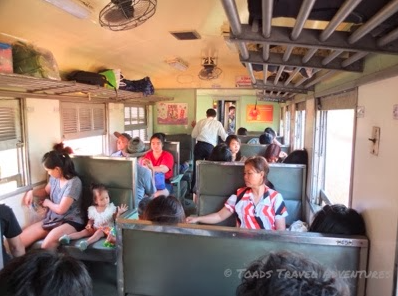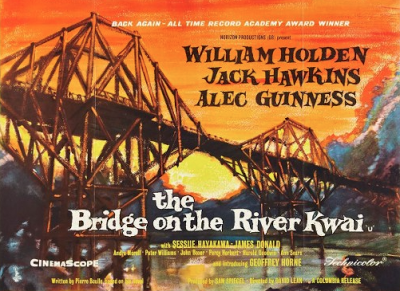The Railway Man

I have been busy planning a few small adventures on the route of my forthcoming journey across the world. Even though my trip will technically finish in Hong Kong, I will be exploring parts of Asia by rail afterwards. One trip that is now firmly in my diary is a visit to “The Bridge on the River Kwai”. You probably know all about this, but just in case you don’t, this is the bridge at the location in Thailand where the Burma “death railway” crosses the Mae Klong river, made infamous by the David Lean’s epic 1957 film. In passing, in case it is of interest, (1) the film was actually shot in Sri Lanka – I visited the location a few year’s ago and (2) the real river had its name changed to the nearby Kwai (Kwae) by the Thai government in the 1960’s to make it all fit the film.

Eric Lomax and Takashi Nagase in 1998. Source: AP/Daily Telegraph
But it is not this film that is making me feel the need to visit. It was the 2013 film based upon Eric Lomax’s book “The Railway Man” that has brought this place into some focus in my mind. I remember reading the book back in 2001 (I know when I read it as I was on jury service. Well not actually serving on a jury, but waiting in court for what felt like days to be selected). I am amazed that the book was not published until 1995. I find the timeline challenging, in that when I first read the book Eric Lomax was still very much alive, but yet he sadly died just the year before the release of the film based upon it. In my mind somehow the real life connection has only very recently been lost. The film also features several scenes shot very close to where I live, which somehow brings it in touch of my every day reality. If its of interest, I found a rather helpful film location map here.
To me the film is one of those (few) that seem to well represent the book it was based upon and brings it to life in such a gentle and thoughtful way. I am sure that this is because it is a British/Austrlian production and the screenplay was made after actually talking to Eric Lomax. They don’t seem to make many films like that in Hollywood these days. For example, did you ever see “U-571”?

The Bridge on the River Kwae today. source: Wikimedia
The bridge still stands in the same place today. It was one of two built here by POW’s. Parts of it were re-enforced after the war, but the spans are the original ones from 1943. The location is near a town called Kanchaburi about 120km west of Bangkok. In 2014 I actually passed close by on my way from Bangkok to Singapore, but the main line passes in a different direction at nearby Nong Pladock Junction on its way west and then south towards Malaysia.
My first port of call when planning such adventures is Seat Sixty-One. I actually got really confused at first here as the information is so detailed that unless you know all the station names it can seem quite a hard trip to organise. But in reality it is in fact very easy. I should be able to hop on a local train from Bangkok taking me all the way to the bridge, where I can get off and either return later in the day, or more likely stay in Kanchaburi returning the next day. This will give me time to walk the bridge, travel onward by to Hellfire Pass and visit the war graves.
In case you are considering this trip, my plan is to take the “257” train from Bangkok’s Thonburi (Noi) station which leaves at 07.50, arriving at the bridge (it has its own station) at 10.44. On the way home what I suspect is the same train (now the “258”) leaves the bridge at 14.38, arriving back in Bangkok Thonburi at 17.40. This allows just under 4 hours at the bridge, so I’m thinking an overnight stop would be good – allowing me to travel further up the line to Nam Tok. Note – Seat 61 says part of the line near Kanchaburi is temporarily closed for improvements, but I’m hopeful this will be complete well before the time I arrive.

My 3rd class carriage from the Thai border at Aranthapet in 2014
The train will be a 3rd class experience, but I’m now a veteran of Thai 3rd class trains, having taken one all the way from the Cambodian border to Bangkok last year (you can read about this adventure here). Its a brilliant way to get in touch with Thai people and their way of life – and best of all there are no windows, so you get the breeze in your face (and the smells, mostly good ones). From memory, all the tour companies in Bangkok sell a trip to the bridge as a bus journey. This has little appeal to me and I shall take quiet satisfaction for being very much on my own – and on the rails – for this trip.

The original poster from the 1957 film. Source: Wikipedia
I shall of course post some pictures and my experiences here once I have been – that will be in January 2016. I have quite a lot of reading to do before I set off. Its worth reading the wikipedia pages – links here: for Eric Lomax, the Bridge and films – they list a variety of written and broadcast sources that really help explain the historical context of all of this.
In other news on the bigger trip, the plan is all coming together. But it is no longer just the “bigger” trip, it’s the massive trip! It has finally sunk in that its longer than I have every attempted before. It’s largely a waiting game for me now as my main agent, Real Russia, are poised like a coiled spring to book tickets on trains as soon as the tickets go on sale. My fingers are crossed about the added complication of a second Chinese agent dealing with some of the ticketing, but it worked out fine last time I did this. Anyway, no point in worrying, there is nothing more I can do. Time to plan side trips like this one.
I have begun to review the visa requirements and see how many of the few remaining pages of my passport will be needed. The big change from last year is that to get a Russian visa the rules have changed, and you now have to visit the consulate in person to provide fingerprints. On the plus side, I have realised that I have my very own Russian Consulate here in Edinburgh, and Real Russia will helpfully provide the support documents – I shall then give them my passport to get the other visas in London.
I have recently dedicated a room in the house to my kit and started piling it into three plastic crates., marked “essential”, “helpful” and “luxury”. The reason I’m doing this now is that I really want time to pair this down to the minimum and test everything well before I leave. In the words of Edmund Blackadder, I don’t want to be “at home to Mr & Mrs Cock Up”, even for the smallest reason. By way of example, last year I realised my phone cable was no longer working whilst crossing the Sea of Japan, with no possibility of getting a replacement. This year I have a back up cable and I have practiced changing the (uncommon) fuse for its charger. I’m also carrying spare fuses. I think that I am taking the preparation from “traveller” to “expedition” level, and this is in line with the increased self reliance that I need to have.
That’s all for now. I’m looking forward to sharing my thoughts with you on the Joanna Lumley Trans-Siberian journey, currently being broadcast here in the UK. I’m holding back until I have seen it all.

Fon
July 24, 2015 at 7:21 pmIt made me to recall the song of James "A boy born beside Railway"!
Train 257 to the Bridge on the River Kwai – Matthew Woodward
September 5, 2017 at 1:08 pm[…] I also got sucked into the history and the amazing story of Eric Lomax. You can read the article here. I actually made the trip earlier this year, so thought it was about time that I shared my […]